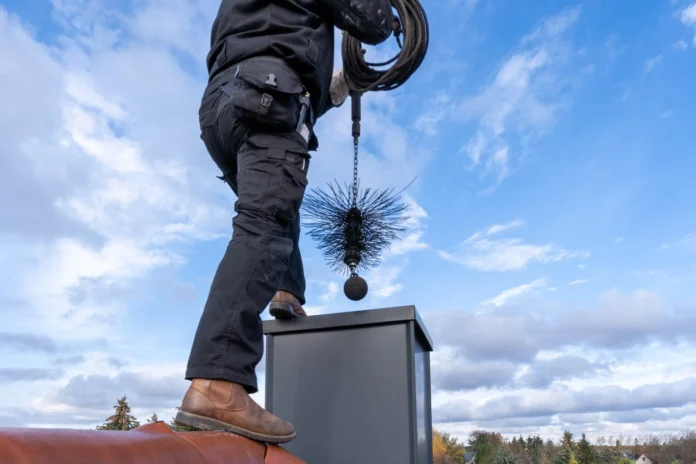Chimney cleaning is an important maintenance chore that protects homes from fire threats and ensures chimneys function properly. Hiring a professional cleaner with the necessary tools might make all the difference in completing a complete cleaning. In this post, we’ll look at the specific instruments used by chimney cleaning professionals and why each piece of equipment is necessary for keeping a chimney safe and functional.
Types of Equipment Used in Chimney Cleaning
Professional chimney cleaning necessitates the use of heavy-duty tools, inspection equipment, and safety gear. Each instrument has a specific purpose, allowing cleaners to safely reach every nook and eliminate dangerous accumulation.
Heavy-Duty Brushes
A brush is one of the most important tools for chimney cleaning, specifically designed to remove soot, creosote, and grime that accumulate in a chimney over time.
Wire Chimney Brushes
Wire brushes are commonly used for masonry chimneys. They come in a variety of sizes and are durable enough to scrape away hardened deposits, resulting in a more complete clean.
Polypropylene Brushes
These brushes are softer than wire brushes and do not damage delicate chimney linings while offering effective cleaning.
Power Brushes
Power brushes are powered and provide a deeper clean. These are often designated for difficult situations involving substantial creosote buildup that manual brushing cannot manage.
Cleaning Rods
Cleaning rods link to brushes, allowing professionals to get further into the chimney flue.
Fiberglass Rods
Fiberglass rods are sturdy but flexible, providing cleaners control as they navigate the chimney.
Aluminum Rods
Aluminum rods are lightweight and corrosion-resistant, making them suitable for long-term usage in a variety of climatic conditions.
Extension Rods
Extension rods make it simple to reach high or long chimneys, ensuring a complete cleaning from top to bottom.
Also Read: Benefits of Chimney Cleaning for Property Value
Industrial Vacuum Systems
Professionals use specialized vacuums to remove debris, soot, and creosote that become loose during the cleaning process.
HEPA-Filter Vacuums
HEPA filter vacuums improve indoor air quality by catching tiny particles and keeping them from circulating back into the home.
Soot Vacuums
Soot vacuums are designed to collect soot and ash and keep it from spreading across floors and furniture.
Inspection Cameras and Video Scopes
Inspection cameras enable cleaners to see difficult-to-reach spots and identify problems before and after cleaning.
Benefits of Visual Inspections
Visual inspections with cameras allow professionals to check for blockages, creosote accumulation, and structural flaws that might otherwise go undetected.
Camera Types Used in Chimney Inspections
There are several types of inspection cameras, including endoscopes and video scopes, that enable thorough inspections of chimney interiors.
Protective Gear for Safety
Safety is critical in chimney cleaning because cleaners are frequently exposed to dust, soot, and creosote.
Respirators and Masks
Respirators and masks keep hazardous particles out of your lungs, preventing respiratory problems.
Gloves and Eye Protection
Heavy-duty gloves and safety goggles are required to protect hands and eyes from sharp objects and dust.
Specialized Scrapers and Chisels
These instruments assist in removing difficult-to-scrape residues and cleaning stubborn locations that brushes may not reach.
Steel Scrapers for Hard Deposits
Steel scrapers enable cleaners to remove creosote layers that are too thick for brushes to handle.
Rotary Chimney Cleaning Systems
Rotary systems use motorized brushes to efficiently loosen and remove debris from chimneys, especially those that are extremely soiled.
Creosote Removal Chemicals
In some circumstances, chimney cleaners will use chemical compounds to remove creosote deposits.
Usage and Safety Tips
These chemicals are only used when absolutely necessary, and they are handled with caution to avoid destroying the chimney liner.
Choosing the Right Products
Only certified creosote removal products are used to assure safety and efficacy.
Chimney Caps and Crown Repair Tools
Many professionals also perform basic repairs, such as inserting caps and fixing the crown.
Benefits of Chimney Caps
Chimney caps prevent animals, rain, and debris from entering the chimney, hence preserving its structural integrity.
Tools for Masonry Repairs
Tools such as trowels and sealants are used to rebuild the crown while keeping it waterproof.
Thermal Imaging Cameras
Thermal cameras can detect heat loss, leaks, and other safety hazards that are unseen to the naked eye.
Common Maintenance Tools
Professionals use ladders, harnesses, and drop cloths to safely access and clean chimneys.
Ladder and Harness Systems
Safety harnesses and ladders are used to safely climb steep rooftops and work at heights.
Tarps and Drop Cloths
Drop cloths shield the interior environment from soot and dust during cleaning.
Modern Technology in Chimney Cleaning
As technology develops, more chimney professionals are utilizing remote-controlled inspection robots to detect difficult-to-reach faults within the chimney structure.
Remote-Controlled Inspection Robots
These robots provide high-definition views and can access regions that would be dangerous for a cleaner to visit.
Choosing the Right Professional for Chimney Cleaning
Hiring a licensed chimney cleaner assures that they have the necessary equipment, training, and experience to accomplish the task safely and thoroughly.
Conclusion
From wire brushes to HEPA filter vacuums, every instrument in a chimney cleaner’s inventory is essential for keeping the chimney healthy. Understanding the equipment involved allows homeowners to appreciate the effort and experience that specialists bring to each service, resulting in safer homes and cleaner chimneys for longer.



